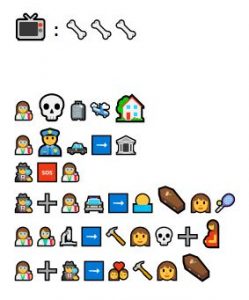
The process and challenges
For me, this task was harder than it seemed like it should be. I started by choosing a show that I have been watching recently. Then I had to write out the plot in simple terms so I had an outline to follow. Even though “the late age of print—is visual rather than linguistic” (Bolter, 2001, p. 48), for me, stories need to be written in words. I understand the appeal and importance of pictures and diagrams, but in my opinion, they should be accompanied by text. Ikea instructions with only pictures and symbols drive me crazy!
Did you rely more on syllables, words, ideas, or a combination of all of them?
As I started on this task, I realized that I would have to use words and ideas to tell the story. I did not try to use syllables. I rarely use emojis, so I needed to do a lot of searching to find appropriate ones to represent the ideas I was trying to convey. It was frustrating since there were some words I could not find an emoji for, so I had to choose something close.
Did you start with the title? Why or why not?
For this TV show, I started with the title, as it seemed to be the easiest part of the assignment. If I couldn’t figure out how to represent the title of the show, I was going to have to pick a different show.
Did you pick the work based on how easy it would be to visualize?
I chose the show based on the ease of representing the title. Once I started with the plot, it wasn’t nearly as easy. I realized how difficult it would be to be detailed and specific, and that emojis can be open to interpretation.
Reference
Bolter, J. D. (2001). The Breakout of the Visual. Writing space: Computers, hypertext, and the remediation of print (2nd ed., pp. 47-76). Mahwah, N.J: Lawrence Erlbaum Associates. https://www.doi.org/:10.4324/9781410600110